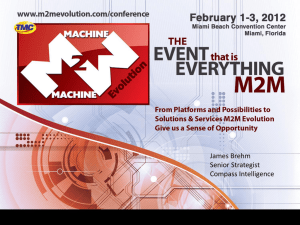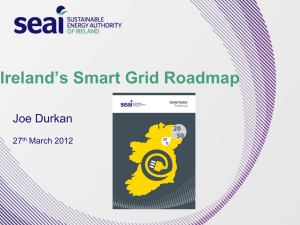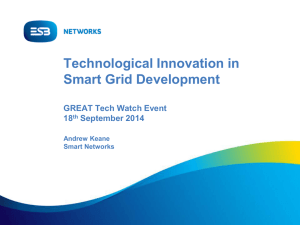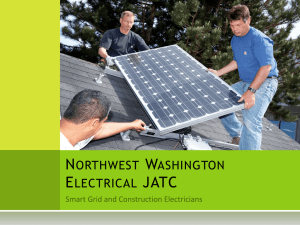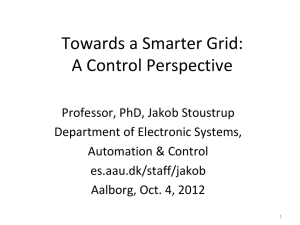Presentation on Knowledge Report
advertisement
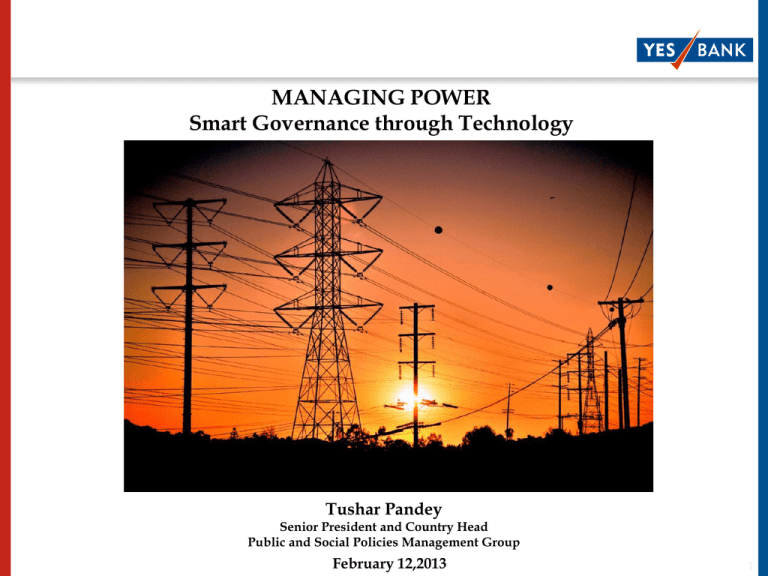
MANAGING POWER Smart Governance through Technology Tushar Pandey Senior President and Country Head Public and Social Policies Management Group February 12,2013 1 Power Sector in India Power Sector in India, is the fourth largest in the world Per-capita consumption of electricity in India is only about one-fourth of the world average and 404 million people in India do not have access to electricity Existing grids are constrained and under pressure to deliver the growing demands for power, along with providing stable and sustainable supply of electricity. India loses $68 billion, or about Rs 4,14,800 crore of its Gross Domestic Product due to electricity shortage. India requires a Robust transmission and distribution (T&D) network to increase evacuation capacity and coverage , prevent cascading failures and transmission losses. 2 Power Sector in India FUEL GENERATION GENERATION CAPACITY - 2,36,387MW, India’s energy basket indicates heavy dependence on thermal power for production of electricity. •India accounts for 4.4% of global energy consumption. •Energy and peak availability shortage is 8.7% and 9%, respectively Energy Generation MW (AT&C) LOSSES were 26.1 which is HIGHEST when compared against largest power producing countries such as China, Japan , US and Russian Federation WEAKEST LINK IN THE INDIAN POWER SECTOR DISTRIBUTION & SUPPLY •Only 67% of households in India have electricity connection •45% of rural households do not have electricity connection DEMAND - 89 GW (12TH FYP) Electric power transmission and distribution losses Thermal Power Hydro (Renewable) Nuclear RES** (MNRE) 2% TRANSMISSION 12% 18% 1% 68% Source: Ministry of Power, GOI 59% 9% Source: World Bank data 3 Smart Grid: Catalyst for Change A smart grid is an electrical grid with automation, communication and IT systems that can monitor power flows from points of generation to points of consumption (even down to the appliances level) and control the power flow or curtail the load to match generation in real time or near real-time. CAPACITY Meeting the growing demands for electricityDemand response management system Real time Operation Management Facilitate evacuation Grid and power RELIABLE NETWORK Monitor grid stability Energy accounting and settlements EFFICIENCY SUSTAINABILITY Augmenting electricity supply on both new as well as existing systems Integration of renewable power sources Smart Meters Demand Management Side Green Buildings Administering green energy certificates mechanisms Improving the country’s energy security by reducing reliance on imported fossil fuels Bring in economies of scale to support large projects as compared to smaller stand-alone renewable energy projects IMPACT Meet fast-growing energy needs in a sustainable manner •Increase capacity of • Emergency Capacity Defer capital existing infra • Prevent load Shedding expenditures •Leverages SMART GRID’s and grid failure nationwide transmission •Infrastructure for telecom •Reduced impact on environment •Balance renewable – integrating VRE 4 Smart Grid Implementation Greenfield Cities DMIC 24 new SMART CITIES Industrial Parks •11 investment regions •13 industrial areas Agro-Processing Zones Supporting Infra – Rail, Airports, Logistics Facilities, Road Generate• Economic activity, Employment • Demand for Power - Total Power Requirement for DMIC corridor is1,700 MW. The composition is as follows: • Industrial: 1000MW • Social: 600MW • Mixed: 100MW Implement SMART GRID INFRA to provide reliable supply of power, thereby, improving the economics of operation, encouraging investment and fostering economic growth. GoI Initiative: SMART GRID - 14 pilot projects have been approved by the government. Implemented National Grid Restructured-Accelerated Power Development and Reform Program (R-APDRP) Green Corridor Various missions aimed at promoting growth of RE Brown-field Implementations Implement through PPP mechanism tailored to each setup BOOT , Concession, VGF etc. 5 Current Policy Framework Ministry of Power formulates the policy structure and takes decisions pertaining to investments in power projects. •Electricity Act, 2003 governs the sector •National Smart Grid Mission •Restructured-Accelerated Power Development and Reform Program (R-APDRP) State Electricity Boards own and operate state grid and distribution network Power Grid Corporation of India Limited (PGCIL) owns and operates inter-regional and inter-state transmission lines, facilitating transfer of power from surplus to deficit regions. Private Sector generation – distribution and power 6 Challenges faced by the Power Sector Timely implementation of projects •Difficulty in obtaining clearance s •Difficulty in acquiring land Power Tariff regulation Regulatory Disputes between center and state •Poor grid discipline Poor infrastructure – poor evacuation and transmission of power Pilferage and high AT&C losses More investment in transmission sector is required 7 Suggestions Standardization of the process for award of projects, within specific time-frame. Single window clearance for Power projects Frame Antitheft legislation to minimize AT&C losses Set up regulatory body to minimize project delays due to disputes Rationalize power tariff to facilitate ‘open access’ and approvals for the same Establish Demand Response Management Clear policy framework defining roles and responsibility of both Center and State 8 Financing • The Twelfth Plan (2012 - 2017) estimates a total investment of INR 95 BN in developing Smart Grid infrastructure. 50 bn Grants through government • Foster private participation: 45 bn Private Sector sector operational efficiencies construction and commercial risk sharing innovative technologies access to additional finances managerial effectiveness Spectrum of Public Private Partnership Options Public Investment Private Provider Government Enabler Service Contract Management Contract Leases Concession BOT BOO divestiture 9 Way Forward Fostering PPP Removing entry barriers for smart grid solution providers Encourage private sector to set up power projects of any size to increase investments and incentive for renovation of existing power plants Ease out legal process by setting up arbitration cell Formulate standard agreement for commissioning power projects Un-bundling or SEBs to bring in transparency, accountability and better management VGF for promoting private sector to take up projects. Bring PPP approvals under the RTI Smart Grid Investment Market Estimated Investment (US$ million) 2015 Software and Hardware 339 Smart Meters 446 Sensors 2236 Comm &wireless 289 Smart and T&D equip 392 Source: ZPRYME 10 Way Forward Coordination between various states and center on policy issues and implementation is required to ensure seamless integration of Smart Grid technologies across the country and facilitate stakeholder participation. Private sector participation would bring efficiency in operations and minimize losses. Suitable measures to augment financial resources facilitating integration of smart and micro grid needs to be established. Framing and enforcing antitheft legislation and legal system for speedy resolution of disputes would foster private sector participation in the distribution sector 11 Way Forward Stakeholder collaboration India has a large pool of professionals and experts in the IT and telecom sector which can be leveraged for development of smart and micro grids. Establishing collaborative community models and fostering empowered consumer base would make way for sustainable power infrastructure. Human Resource Development Smart Grids enable the more sophisticated use of the electricity system requiring development of Skill development and Training infrastructure. 12th FYP envisages a capacity addition of about 1,00,000 MW (including renewable) requiring a work force of the order of 4 lakh out of which nearly 3 lakh will be technical. 12 Social Equity 1. Social Equity • Transmission projects face delay due to inability to acquire land • Social Equity Model can facilitate timely implementation of projects by partnering with local community , ensuring their support and equity in project. Facilitating Land Acquisition Facilitating synergetic partnerships NGO Government Structure Social Equity Advisory and PPP implementation Knowledge Bank Local Community Contribute Land 2. Community Energy Partnership Program (Ontario, Canada) Ontario’s FIT (Feed In Tariff ) program provides guaranteed purchase of all of the power supplied by renewable energy projects for 20 years (40 years for waterpower) at a fixed price that is high enough to generate a reasonable rate of return. 3. Transmission lines Equity in Project Employment Empowerment Industries and commercial establishments in Tamil Nadu are letting out their lands or rooftops in return for cheaper solar power. Promoter (Entrepreneur/s or Company) Private Sector Efficiency 13 Alternate Financing Mechanism Plan Frame plan to study towards establishing financial viability of smart grid Increase coverage and Consumer Base Installing Renewable Energy sources should qualify as PSL Utilize M-commerce industry for power sector Branch Correspondents to provide due diligence of co-operative for implementing micro-grid projects Study Incremental Benefit- understanding Smart Grid Value Chain POWER FOR ALL Emissions Offset cost – Govt. Subsidy Kerosene /other fuel sources 404 million people in India do not have access to electricity SMART GRID Meet energy need Reduce AT & C losses Integrate Renewable Sources and hence reduce environment impact Reduce dependence on fossil fuels and their imports 14 Contacts YES BANK Limited Northern Regional Corporate Office: 48 Nyaya Marg, Chanakyapuri, New Delhi 110 021 Tel: + 91 11 6656 9000; Fax: +91 11 4168 0144 Public and Social Policies Management (PSPM)Group Tushar Pandey, Senior President & Country Head Northern Regional Corporate Office: 48 Nyaya Marg, Chanakyapuri, New Delhi 110 021 Tel: + 91 11 6656 9056; Email-tushar.pandey@yesbank.in About YES BANK YES BANK, India’s new age private sector Bank, is the outcome of the professional commitment of top management team, to establish a high quality, customer centric, service driven, private Indian Bank catering to the “Future Industries of India”. YES BANK has adopted international best practices, the highest standards of service quality and operational excellence, and offers comprehensive banking and financial solutions to all its valued customers. A key strength and differentiating feature of YES BANK is its knowledge driven approach to banking and an unprecedented customer experience for its retail and wealth management clients. YES BANK is steadily building Corporate and Institutional Banking, Financial Markets, Investment Banking, Corporate Finance, Business (SME) and Transactional Banking, Retail Banking and Wealth Management business lines across the country. YES BANK has institutionalized YES International Banking that offers a complete suite of international banking products and services, driven by state-of-the-art technology, which includes Debt, Trade Finance, Corporate Finance, Investment Banking and Business Advisory Services, Treasury and Global Indian Banking. The Bank’s constant endeavor is to provide a delightful banking experience expressed with simplicity, empathy and totality. 15 Disclaimer YES BANK Limited Registered & Corporate Office: Nehru Centre, 9th Floor, Discovery of India, Worli, Mumbai 400018 Tel: + 91 22 6669 9000; Fax: + 91 22 6669 9018 Northern Regional Corporate Office: 48 Nyaya Marg, Chanakyapuri, New Delhi 110 021 Tel: + 91 11 6656 9000; Fax: +91 11 4168 0144 Disclaimer No representation or warranty, express or implied is made as to, and no reliance should be placed on, the fairness, accuracy, completeness or correctness of such information or opinions contained herein. The information contained in this presentation is only current as of its date. Certain statements made in this presentation may not be based on historical information or facts and may be “forward looking statements", and future developments and the competitive and regulatory environment. Actual results may differ materially from these forward-looking statements due to a number of factors, including future changes or developments in the Company’s business, its competitive environment and political, economic, legal and social conditions in India. This communication is for general information purpose only, without regard to specific objectives, financial situations and needs of any particular person. This presentation does not constitute an offer or invitation to purchase or subscribe for any shares in the Company and neither any part of it shall form the basis of or be relied upon in connection with any contract or commitment whatsoever. The Company may alter, modify or otherwise change in any manner the content of this presentation, without obligation to notify any person of such revision or changes. This presentation can not be copied and/or disseminated in any manner. 16
